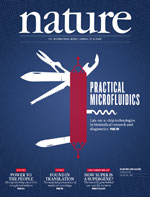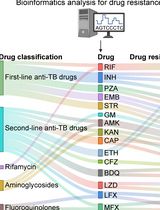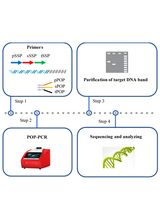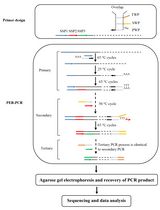- EN - English
- CN - 中文
Purification and Sequencing of DNA Guides from Prokaryotic Argonaute
原核Argonaute的DNA引导子的纯化和测序
发布: 2014年11月20日第4卷第22期 DOI: 10.21769/BioProtoc.1293 浏览次数: 14655
评审: Fanglian HeAnonymous reviewer(s)
Abstract
Some proteins utilize nucleic acids to guide them to complementary nucleic acid targets. One example is prokaryotic Argonaute protein, which, binds small single stranded DNA molecules as guides (Swarts et al., 2014). This protocol describes a method to purify DNA guides from these proteins. It also describes a PCR-based method to enrich the guides by PCR amplification. This methods relies on addition of a poly-A tail at the 3’-end of the ssDNA molecules by Terminal Deoxynucleotidyl Transferase (TdT), followed by ligation of a oligonucleotide to the 5’-end of the ssDNA molecule using T4 RNA ligase, and amplification by PCR. The generated dsDNA products are suitable for traditional cloning and sequencing and high-throughput sequencing. Importantly, the information which strand matches the ssDNA molecule is not lost during this process.
Materials and Reagents
- Purifying nucleic acids from proteins
- Purified protein and co-purified nucleic acids in purification buffer (e.g. TtAgo with siDNA guides)
Note: Please refer to the protocol “Expression and Purification of the Thermus thermophilus Argonaute Protein” (Swarts et al., 2014b).
- Proteinase K solution (20 mg/ml) (Life Technologies, Ambion®, catalog number: AM2548 )
- CaCl2 solution (50 μM)
- Roti phenol/chloroform/isoamyl alcohol (pH 7.5-8.0) (Carl Roth, catalog number: A156 )
- 99% ethanol
- 70% ethanol (pre-cooled to -20 °C)
- Linear acrylamide (5 mg/ml) (Life Technologies, Ambion®, catalog number: AM9520 )
Note: Alternatively, a house-made Linear Acrylamide can be used (http://www.uvm.edu/~tpdelane/lab/protocols/LinearPolyAcryl.htm).
- RNase free MQ water
- Additional materials and reagents required for analysis of purified nucleic acids (optional)
- T4 polynucleotide kinase (PNK) (New England Biolabs, catalog number M0201 )
- T4 polynucleotide kinase reaction buffer (New England Biolabs, catalog number M0201)
- T4 polynucleotide kinase (PNK) (New England Biolabs, catalog number M0201 )
- Purified protein and co-purified nucleic acids in purification buffer (e.g. TtAgo with siDNA guides)
- Enriching and preparing ssDNA molecules for sequencing
- Purified single stranded DNA nucleotides in MQ water (e.g. see Procedure part A "purifying nucleic acids from proteins")
- RNase A (DNase and protease-free) (10 mg/ml) (Thermo Fisher Scientific, catalog number: EN0531 )
- Terminal Deoxynucleotidyl transferase (TdT) (recombinant) (Life Technologies, InvitrogenTM, catalog number: 10533-073 )
- Terminal Deoxynucleotidyl transferase (TdT) buffer (Life Technologies, InvitrogenTM, catalog number: 16314-015 )
- dATP (100 mM) (Thermo Fisher Scientific, catalog number: R0141 )
- QIAquick nucleotide removal kit (QIAGEN, catalog number: 28304 )
- Primer A (5’-GAGAGAGGATCCCGAATTGTGCAGCTGTCAATCAACC-3’) (5 μM)
- T4 RNA ligase 1 (New England BioLabs, catalog number: M0204 )
- T4 RNA ligase reaction buffer (10x, supplied with T4 RNA ligase 1)
- ATP (10 mM) (supplied with T4 RNA ligase 1)
- PEG8000 (supplied with T4 RNA ligase 1)
- Primer B (5’-GAGAGAGGATCCTTTTTTTTTTTTTTTTTTTTTTTTTTVN-3’) (5 μM)
- Pfu DNA polymerase (or equivalent)
- 10x Pfu DNA polymerase buffer (or equivalent, supplied with MgCl2 or MgSO4)
- dNTPs (5 μM)
- 2% agarose gel
- Generuler low range DNA ladder (Thermo Fisher Scientific)
- GeneJET gel extraction kit (Thermo Fisher Scientific, Fermentas, catalog number: K0691 )
Note: Additional materials and reagents required only if ssDNA is not 5’-end phosphorylated: T4 polynucleotide kinase (PNK, New England Biolabs, catalog number: M0201) and T4 polynucleotide kinase reaction buffer (New England Biolabs, catalog number: M0201).
- Purified single stranded DNA nucleotides in MQ water (e.g. see Procedure part A "purifying nucleic acids from proteins")
Equipment
- Purifying nucleic acids from proteins
- Heat block
- PCR machine
- Cooled table top Eppendorf centrifuge
- Freezer (-20 °C)
- Heat block
- Enriching and preparing ssDNA molecules for sequencing
- Heat block
- PCR machine
- Table top centrifuge
- Agarose gel electrophoresis equipment
- Heat block
Procedure
文章信息
版权信息
© 2014 The Authors; exclusive licensee Bio-protocol LLC.
如何引用
Swarts, D. C., Westra, E. R., Brouns, S. J. J. and Oost, J. V. D. (2014). Purification and Sequencing of DNA Guides from Prokaryotic Argonaute. Bio-protocol 4(22): e1293. DOI: 10.21769/BioProtoc.1293.
分类
微生物学 > 微生物遗传学 > DNA
分子生物学 > DNA > DNA 提取
分子生物学 > DNA > DNA-蛋白质相互作用
您对这篇实验方法有问题吗?
在此处发布您的问题,我们将邀请本文作者来回答。同时,我们会将您的问题发布到Bio-protocol Exchange,以便寻求社区成员的帮助。
Share
Bluesky
X
Copy link














